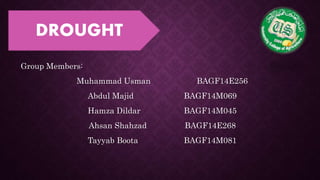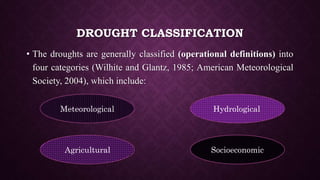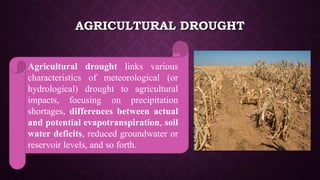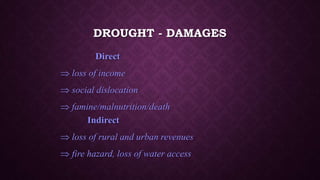Drought
- 1. Group Members: Muhammad Usman BAGF14E256 Abdul Majid BAGF14M069 Hamza Dildar BAGF14M045 Ahsan Shahzad BAGF14E268 Tayyab Boota BAGF14M081 DROUGHT
- 2. DROUGHT Drought is defined as a period in which a region has a deficit in its water supply whether surface or underground water . A drought can last for months or years, or may be declared after as few as 15 days. Generally, this occurs when a region receives consistently below average precipitation.
- 3. DROUGHT • A drought is an extended period of dry weather leading to extreme dryness. • This results in a shortfall of water supply which has hydrological and agricultural impacts. • Drought is different from most other hazards as it develops slowly as a creeping hazard. • Aridity and desertification are associated with drought but they are not the same. • Drought is characterized by moisture level below normal for the area affected.
- 4. SOME OF THE COMMONLY USED DEFINITIONS (CONCEPTUAL) ARE: • The World Meteorological Organization (WMO, 1986) - ‘drought means a sustained, extended deficiency in precipitation.’ • The UN Convention to Combat Drought & Desertification (1994) - ‘drought means the naturally occurring phenomenon that exists when precipitation has been significantly below normal recorded levels, causing serious hydrological imbalances that adversely affect land resource production systems.’ • The Food and Agriculture Organization (FAO, 1983) of the United Nations - ‘the percentage of years when crops fail from the lack of moisture.’
- 5. DROUGHT CLASSIFICATION • The droughts are generally classified (operational definitions) into four categories (Wilhite and Glantz, 1985; American Meteorological Society, 2004), which include: Meteorological Agricultural Hydrological Socioeconomic
- 6. METEOROLOGICAL DROUGHT Meteorological drought is usually defined on the basis of the degree of dryness (in comparison to some “normal” or average amount) and the duration of the dry period. Definitions of meteorological drought must be considered as specific to a region since the atmospheric conditions that result in deficiencies of precipitation are highly variable from region to region.
- 7. AGRICULTURAL DROUGHT Agricultural drought links various characteristics of meteorological (or hydrological) drought to agricultural impacts, focusing on precipitation shortages, differences between actual and potential evapotranspiration, soil water deficits, reduced groundwater or reservoir levels, and so forth.
- 8. HYDROLOGICAL DROUGHT Hydrological drought is associated with the effects of periods of precipitation (including snowfall) shortfalls on surface or subsurface water supply (i.e., streamflow, reservoir and lake levels, groundwater). The frequency and severity of hydrological drought is often defined on a watershed or river basin scale. The effects of precipitation shortfalls on stream flows and reservoir, lake, and groundwater levels.
- 9. SOCIOECONOMIC Socioeconomic - This occurs when physical water shortage starts to affect people, individually and collectively or, in more abstract terms, most socioeconomic definitions of drought are associated with the supply and demand of an economic good.
- 11. DROUGHT - DAMAGES Direct loss of income social dislocation famine/malnutrition/death Indirect loss of rural and urban revenues fire hazard, loss of water access
- 12. DROUGHT CAUSES CAN BE CLASSIFIED IN TWO WAY. THESE ARE… • Global Warming • Deficiency of Rainwater • Weather (hot + dry) • EL-NINO • Soil Erosion • Overpopulation • Over cultivation • Deforestation • Over extraction of ground water • Politics Natural Human made











